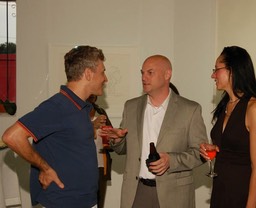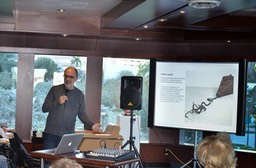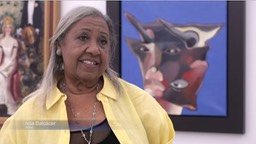Visual art: Artists’ talks, events make their works more accessible
BY GEORGE FISHMAN
SPECIAL TO THE MIAMI HERALD
7/20/14
Audio
• Hear Cheryl Brutvan bitly.com/CherylBrutvanArtistTalks.
• Hear Susan Caraballo bitly.com/SusanCaraballoArtistTalks.
• Hear Chana Sheldon bitly.com/ChanaSheldonArtistSupport.
• Hear Amanda Sanfilippo bitly.com/AmandaSanfilippoRoundtables.
Who hasn’t stood before a canvas, a sculpture, an assemblage of feathers and wondered, “What was the artist thinking?”
In South Florida, more and more artists are answering that question, explaining themselves through talks at museums, welcoming viewers into their studios for one-on-one encounters and conducting Web-based chats. The range and tone of presentations is vast: from Coco Fusco’s socio-political-gender analysis of arts coverage in the media to a recent casual evening at Cannonball (www.cannonballmiami.org), when audience members were encouraged to smack open piñatas representing interaction with debt.
Collector and art enthusiast Manita Brug-Chmielenska described Simón Vega’s recent ArtTable (bit.ly/ArtTableFlorida) talk as one of the standouts in recent memory. “The artist so vividly described his assemblages, inspired by various spacecraft, that we could picture them just from his words.” He uses found objects — even garbage — that he collects from the streets in El Salvador, where he’s from, and in the cities where he builds and exhibits his work. “This was a challenge in Switzerland,” husband Randy Berman said, “because they don’t have a lot of junk lying around!”
Curious art lovers gain insight and a chance to ask the artist directly, “What was on your mind?” Artists get to share their passions, the technical challenges, their personal histories. They reap energized followers and potential sales. And art presenters get people in the door and coming back.
“One of the great things about contemporary art is the artist is living,” says Cheryl Brutvan, director of curatorial services and chief curator of contemporary art at the Norton Museum of Art (www.norton.org) in West Palm Beach. “ … and if you have questions there’s the chance that you can ask them of the creator.”
Artists’ ability to articulate the “method in their madness” can certainly influence the response of a visiting curator, writer or prospective collector — and not just in the commercial sense. Still, artists’ talks can be an effective marketing tool.
At Yeelen Gallery (www.yeelenart.com) in Miami, painter Joseph Adolphe was able to talk at length and individually to visitors last month at a catered sit-down dinner. Yeelen director Karla Ferguson and Prizm Art Fair director Mikhaile Solomon (www.prizmartfair.com) collaborated to present Adolphe’s vigorously textured figurative paintings for about 14 guests. Then, Adolphe conducted an exhibition tour. He characterized the event as a welcome counterpoint to traditional gallery openings where the artist “is usually engulfed in all kinds of frantic and socially difficult acrobatics with several people at a time.” Ideally, he said, “You have an opportunity to more clearly articulate what is a fantastically complex thing: your reason for painting. This last point really can’t be put into words on a page … but rather in the totality of the experience of hearing an artist talk about their work, in front of the work and with people who are not in a hurry and have no expectations.”
Multimedia artist Michael Jones McKean was recently in conversation with colleague Gean Moreno at Tyler-Dorsch Gallery(www.dorschgallery.com) in Wynwood, where he was grateful to have avoided a didactic format. “A question or comment has the possibility to swerve you way off your map — this is exactly what’s hoped for and what a really good session does — it opens up new space in one’s brain; new pathways get formed. This approach feels way more generative, more real, less performative. Of course, I prefer it.”
Amanda Sanfilippo, development associate atLocust Projects alternative arts space (www.locustprojects.org) would agree. She organizes Locust Roundtables, where “people talk about what they want to talk about in exactly the way they want to talk about it.” She steers clear of projectors, “because when you start to project images it starts to become that viewer-audience thing, and this is really about looking at each other and literally talking and using everything we have in our mental equipment.”
Christy Gast is a multi-disciplinary artist who takes on environmental land-use and social issues. She is also on the board of AIRIE (www.airie.org), a residency program for artists to explore Everglades National Park through the visual arts, sound and writing. Gast sometimes moderates their presentations. “In these scenarios, young artists can meet more experienced artists, and non-artists can contribute their thoughts to the conversation, creating a very open, inclusive and unpredictable atmosphere.”
Cannonball, in downtown Miami, provides professional development services for artists — including legal advice. Its residency program offers long-term live/work space for local artists and short-term residencies for visitors — some in partnership with Pérez Art Museum Miami (www.PAMM.org).
Eddie Arroyo, a painter and blogger (www.ArtIsAbout.com), recently attended a Cannonball presentation by multidisciplinary artist and writer Coco Fusco. The takeaway for him was, “It’s necessary to engage in social change. Coco’s talk was very encouraging. It gave us all permission to upset people and get in trouble through critical writing.”
For Bonnie Clearwater, artist talks were a regular feature at North Miami’s Museum of Contemporary Art (MOCA — www.mocanomi.org), which she led for 18 years. Now director and chief curator at NSU Museum of Art Fort Lauderdale (www.moafl.org), she continues to build upon the format. Complementing Bob Adelman’s recent show of Civil Rights Movement photographs, the artist shared his “oral history” of dramatic events from 50 years ago, making them relevant to current issues.
Concerning Belonging is an NSU residency program that combines social activism and art production, tapping into the creativity of the residents of a local homeless shelter to produce artwork in various media. The program provides studio space and allows visitors to engage the artists. Monthly talks will reveal the collaborative project’s progress.
From the patrons’ perspective, the takeaway from an artist talk can be as unique as each member of the audience. This month’s opening of The Miami Generation Revisited at NSU featured a talk with six of the nine Cuban-born artists who first exhibited at the Cuban Museum in 1983.
Audience member Marylynne Newmark reflected on the artists’ youthful exile. “Hearing their joint experience, and especially that several of them were Pedro Pan [refugees], gave me a great deal of warmth. You get to feel the emotion that they felt in putting forth their work.”
Ananda DeMello, director of exhibitions at the Bakehouse Art Complex ( www.bacfl.org), described the impassioned presentation that accompanied a recent exhibition. “At the SOS Venezuela talk, the artists shared the emotional accounts of their families’ experiences with government brutality and how the quality of life under the communist regime is constantly degrading.
“As the artists shared, the audience became compelled to participate, and many shed tears as they joined in with their own stories.”
Being an accomplished artist doesn’t mean you’re a great presenter.
“I know a lot of artists that have a really hard time speaking about their work,” says Susan Caraballo, artistic director of ArtCenter/SouthFlorida ( www.artcentersf.org) on Miami Beach’s Lincoln Road. Its collection of studios is readily accessible to the public.
“When you get to engage the public on a regular basis, it is a muscle that you exercise. The artists here exercise that muscle daily.”
Caraballo’s background is in performance, and she says that preparation is vital. “When I’m the one leading the talk, I create a script for myself to really keep track of what we’re discussing and try to maintain time as much as possible, leaving a little bit of room for improvisation, of course. I like to send the questions that I’m going to ask the participants … for them to review it, and they can start thinking about their answers.”
PAMM offers a wide range of multigenerational programming that includes commissioned artworks, performances, film series and researchers-in-residence. Large venues and audiences can be a challenge to intimacy. One strategy: tightly focused gallery and studio videos, such as the one of 11 artists from PAMM’s exhibition Caribbean: Crossroads of the World, who effectively exploit this vehicle — though without Q&A. Now accessible online, these would also make good audio tours.
Brutvan, of the Norton, was surprised that Nick Cave, a former dancer famous for his extravagant ceremonial “soundsuits,” was a shy speaker. “Thankfully,” she said, “through the relationship that we established and the enthusiasm and response of the audience … it was more than revealing, it was really poignant.”
Sometimes an artist’s materials and methods beg explanation. José Diaz, exhibitions curator at the Bass Museum ( www.bassmuseum.org) in Miami Beach, praised El Anatsui’s talk, a conversation with executive director Silvia Karman Cubiña. The artist elucidated the aesthetics, technique and social context of the bottle caps he uses to create gigantic wall tapestries.
Brutvan concludes that everyone leaves a close encounter with an artist enriched. “A public presentation with a living artist is a privilege,” she says. “It’s a privilege for the museum to host, it’s a privilege for the curator to have that kind of forum and it’s a privilege for the public to have that access and engage and learn from that kind of conversation.”
IF YOU GO
NSU Museum of Art Fort Lauderdale
• Sean Black: Human Nature & The Oblivion of Being. Artist will discuss his latest photo series, Human Nature, which explores the socio-economic dilemma of homelessness. 2 p.m. Aug. 16.
• Panel Discussion on Cuban Art with Ramón Cernuda and Margarita Cano. An expert on Cuban art, Cernuda is a publisher, editor, writer, collector and gallerist. Cuban-born artist Cano organized the landmark exhibition, The Miami Generation in 1983. 2 p.m. Aug. 23.
• César Trasobares: Among Friends in Context. Trasobares, whose work is featured in “The Miami Generation: Revisited,” will discuss his memoir that explores his connections to Carlos Alfonzo, Ana Mendieta and Felix González-Torres. 2 p.m. Sept. 6.
Art & Culture Center of Hollywood
• Artist/musicians from Echos Myron discuss their exhibition and cross fertilization between art and music in Miami. Sept. 24, reception at 6:30 p.m., talk at 7 p.m. Moderated by Gean Moreno.
• Dave Muller exhibition “Too Old to Rock ‘n’ Roll” plus. Nov. 14-16: an interactive outreach event; artist talk in which Muller spins records from his vinyl collection; and “takeaway day,” in which the artist creates something for attendees. www.artandculturecenter.org.
Norton Museum of Art
• British-born painter Terry Haggerty, working in the tradition of geometric abstraction, will create a wall installation in the Norton lobby. Cheryl Brutvan is keen to host his artist talk, “so viewers baffled by geometry in art can hear first-hand why it’s important.” Sept. 23.
Locust Projects
• Sarah Crowner features three artists in conversation. For her exhibition, Crowner has invited multimedia artist Sari Carel to create a surround-sound collage and Miami-based printmaker Amanda Keeley to collaborate on a set of experimental prints. 7 p.m. Sept. 13.
Pérez Art Museum Miami
• Lynne Golob Gelfman book signing and talk with chief curator Tobias Ostrander. Artist will describe her complex painting process. 4: 30 p.m. July 26.
• First solo museum exhibition for Adler Guerrier surveys 15 years — across diverse media. He will speak with curator Diana Nawi about his interest in Miami history, the ’60s legacy and the influence of cinema and literature on his practice. 7 p.m. Aug. 7.
Frost Art Museum
Breakfast in the Park: Daniel Arsham, a contemporary American artist whose art blurs the lines between art, architecture and performance. 9:30 a.m. Dec. 7.
Art Center/South Florida
• Laura Vinci talks about her “Loose Papers” installation at ArtCenter/South Florida. Know for approaching architectural settings with wonder and precision. 7 p.m. July 23.
• Nothing Goes to Waste is a solo exhibition by Miami-based artist Gustavo Oviedo, who creates and recreates utilizing canvases, photography, vinyl, drawings, video and found objects. 7 p.m. Aug. 6.
Dina Mitrani Gallery
Rafael Diaz, a former physician from El Salvador, will speak about his photo series Anonymous, which gallery director Mitrani describes as “studies of the colorful array of the human form.” Sept. 6. www.dinamitranigallery.com.
Dimensions Variable
Plot is a solo exhibition by New Zealand-born artist Jude Broughan. 6 p.m. Sept. 6. dimensionsvariable.net.
Farside Gallery/Art@Work
• Scaping Back Art@Work exhibition walk-through with artist Ramón Williams and art critic Alfredo Triff. Williams, whose idiosyncratic cityscapes/installation feature barricade markings and tire tracks, is also a natural performer/actor and Triff a philosopher and thoughtful writer. 7 p.m. July 24.
• Memory of War exhibition walk-through with artists Ana Olema and Annelys PM Casanova and exhibit curator, Ernesto Oroza. Olema and Casanova are noted for their provocative depiction of the Cuban government’s mistreatment of dissidents. 7 p.m. Aug. 2.www.farsidegalleryartatwork.blogspot.com.
Yeelen Gallery
• James B. Clover’s sculpture career spans more than 30 years. His work is found in museums and parks across the country. 7 p.m. Sept. 13.
• Tim Okamura depicts African-American and minority figurative subjects in urban settings. He combines a realist approach with spray paint and mixed media. 7 p.m. Nov. 22.


